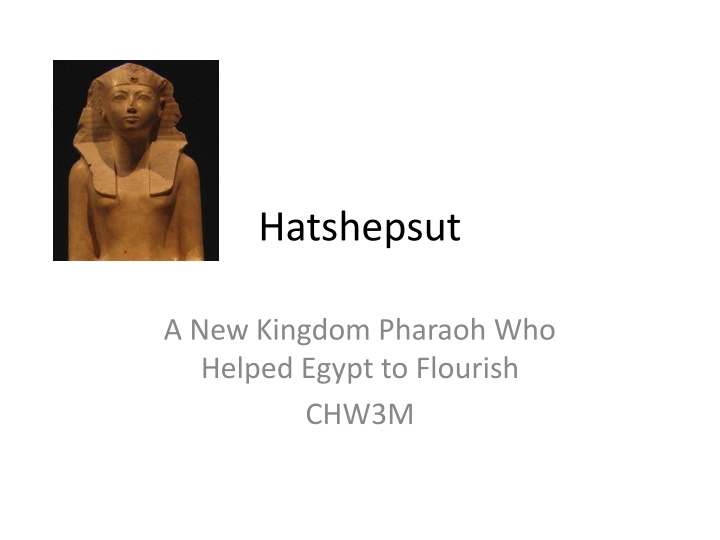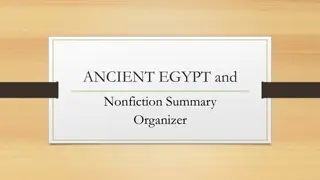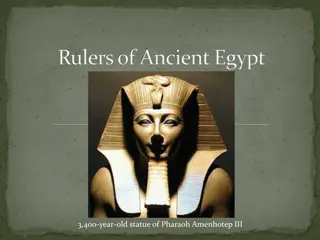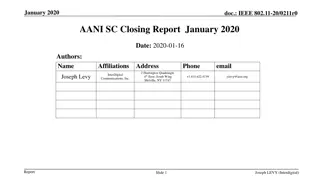
Hatshepsut: The Enigmatic Pharaoh of Ancient Egypt
Discover the fascinating story of Hatshepsut, a New Kingdom Pharaoh who helped Egypt flourish, only to be erased from her own monuments. Uncover her rise to power, her mortuary temple, and the mysteries surrounding her reign. Learn about the legal rights and domestic roles of women in ancient Egypt, alongside the concept of Ma'at. Explore how Hatshepsut depicted herself to legitimize her rule, challenging societal norms and leaving a lasting legacy.
Download Presentation

Please find below an Image/Link to download the presentation.
The content on the website is provided AS IS for your information and personal use only. It may not be sold, licensed, or shared on other websites without obtaining consent from the author. If you encounter any issues during the download, it is possible that the publisher has removed the file from their server.
You are allowed to download the files provided on this website for personal or commercial use, subject to the condition that they are used lawfully. All files are the property of their respective owners.
The content on the website is provided AS IS for your information and personal use only. It may not be sold, licensed, or shared on other websites without obtaining consent from the author.
E N D
Presentation Transcript
Hatshepsut A New Kingdom Pharaoh Who Helped Egypt to Flourish CHW3M
Hatshepsuts Mortuary Temple at Deir El Bahri: it reflects a person who was Ancient Egypt Online, Hatshepsut s Mortuary Temple, 2010, http://www.ancientegyptonline.co.uk/hatshepsutmorttemple.html (Sept. 28, 2015)
How did she go from magnificent temple to being erased from her own monuments 20 years after her reign ended? The Silk Route, Egypt: Luxor and the West Bank of the Nile, N.d., http://www.the-silk-route.co.uk/egypt2.htm (Sept. 28, 2015).
Maat A concept and a goddess = Order of life balance harmony truth justice
Context on Women Page # Heading Details 77 Legal rights of women - Same as men - Own and sell land and property - Divorce - Start a court case - Be a witness in court - Go out in public without being covered up - Economic independence Head of family More than one wife legal but not common economically difficult Pass on occupation to sons continuity Men s roles
Page # Heading Details Domestic roles - Primarily to raise children - In charge of home life - Bake bread - Brew beer - Portrayed as yellow in colour in art - To show them spending time indoors (vs. men portrayed as red to show them spending time outdoors in the sun) Lack of political power - No titles - No political power (except for a few)
Hatshepsuts Rise to Power 1479-1457 BCE Daughter of Thutmose I married to Thutmose II, her half brother (not uncommon in ancient Egypt) she was the step mother of Thutmose III who inherited the throne but was too young to rule so she acted as regent (ruled in place of him) and co-ruler eventually she declared herself pharaoh (king) ruled for 22 years Garfield Newman, et al., Echoes from the Past (Toronto: McGraw-Hill Ryerson, 2001), p. 63.
Video Questions Egypt s Golden Empire https://www.youtube.com/watch?v=Uqh7vYKMz9 Q 22:24 - 26:30, 26:45 - 27:01 Describe 3 actions Hatshepsut took to persuade Egyptians of the legitimacy of her rule. How did she depict (portray) herself?
Consolidation Back to original inquiry question: Did religion help Egypt deal with change?













